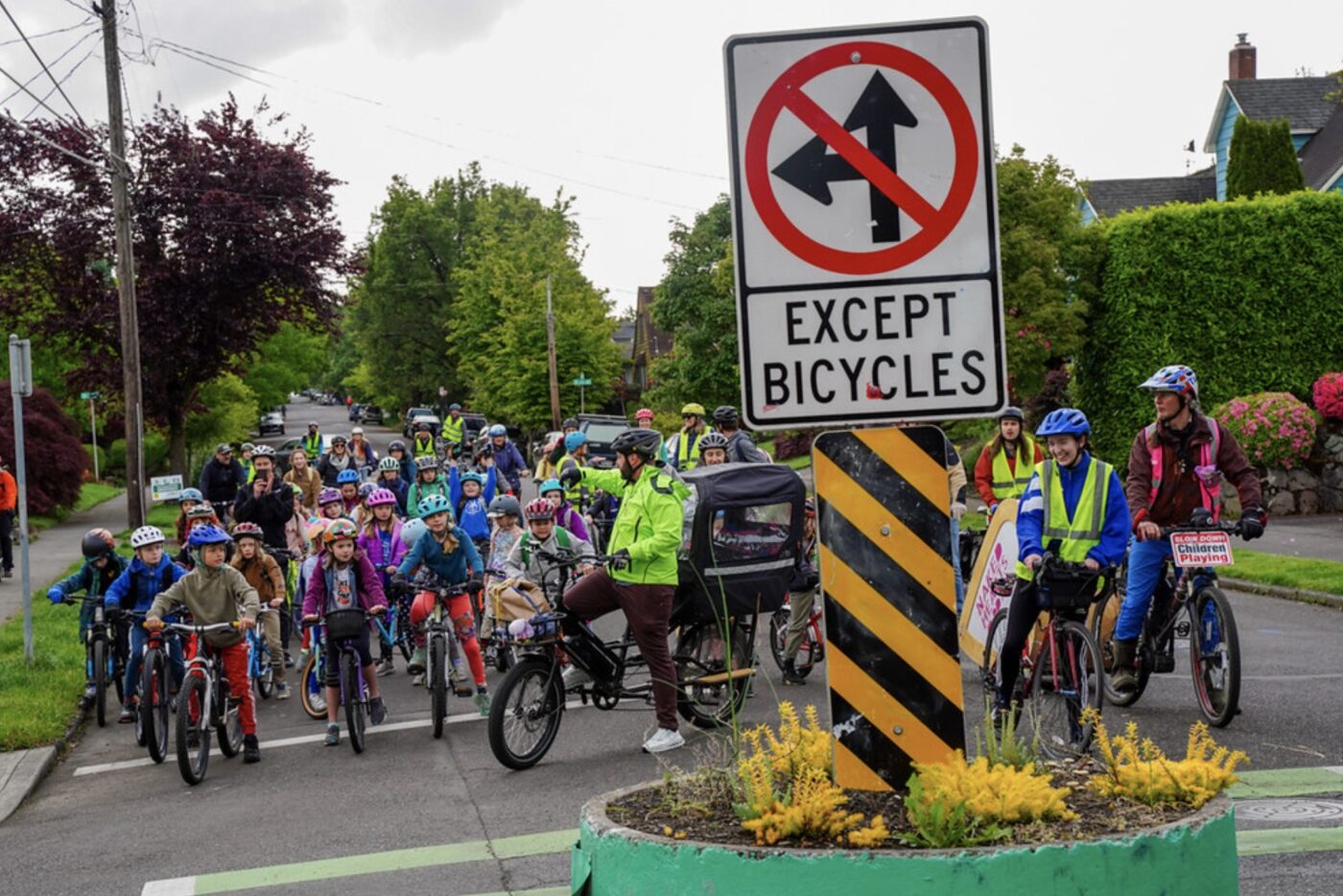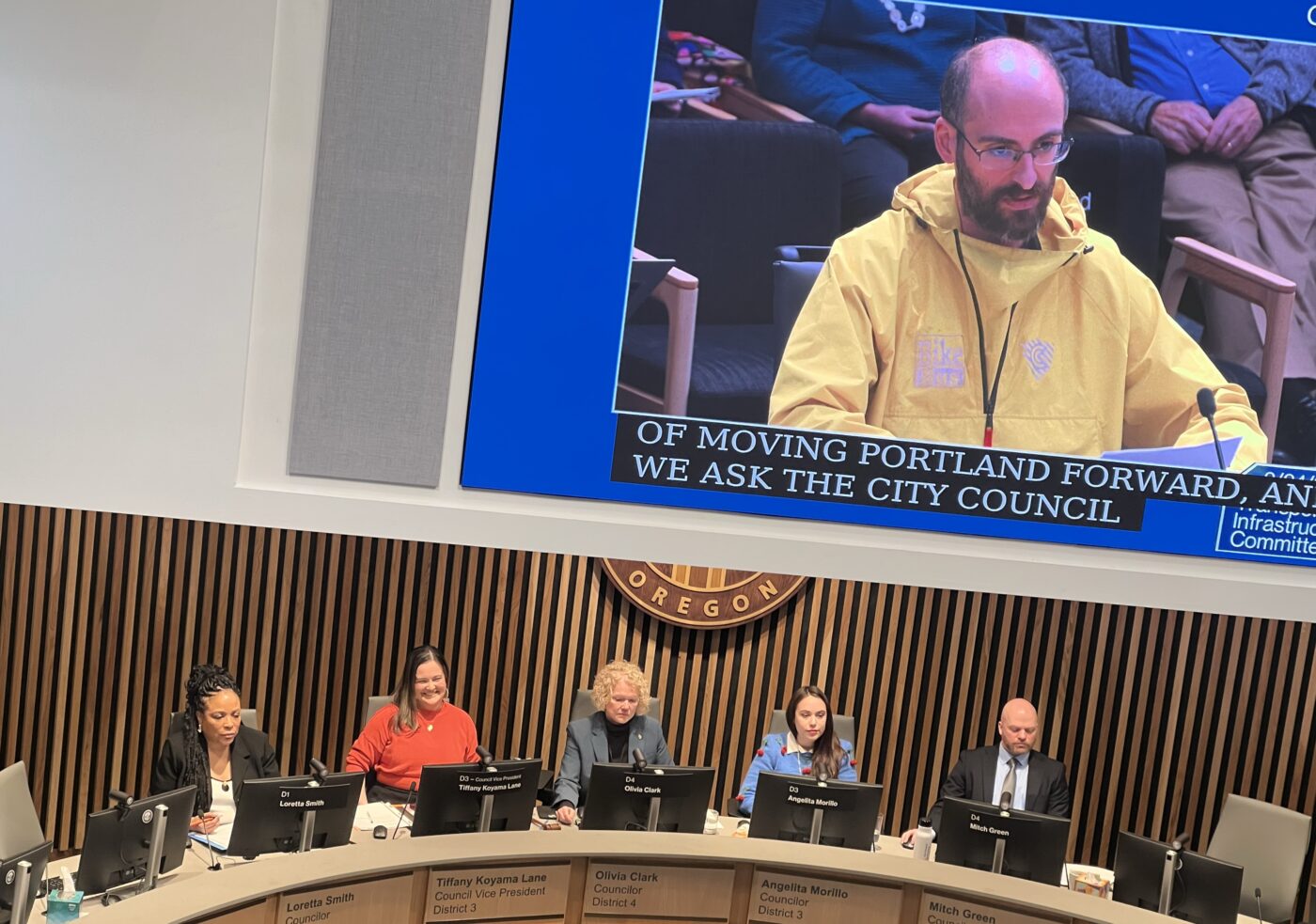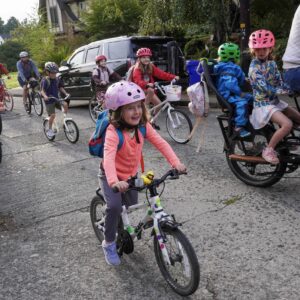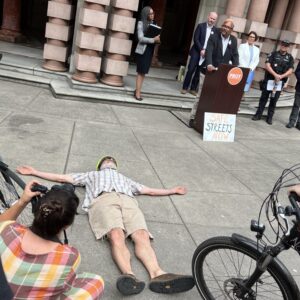
The bike bus movement in Portland isn’t all about fun bike rides to school. It’s also a platform for advocacy. And as those rides have grown, so too has the ability of their leaders to pressure city council for safer streets. After all, an elected can’t say they support bike buses if they don’t also support making sure kids can join them safely.
At the Transportation and Infrastructure Committee meeting in City Hall on Monday, Glencoe Elementary School Bike Bus Leader Rob Galanakis told councilors it’s time for Portland to step up and capitalize on the remarkable bike bus momentum. “The bike bus is the software for change, the social infrastructure,” Galanakis said, wearing the bright yellow rain poncho that’s become a de facto bike bus flag. “But we need the city to provide the physical infrastructure, the hardware.”
That “hardware” is modal filtering — an approach that uses hard infrastructure to limit cut-through traffic while still allowing people to walk and roll. (“Modal filtering” is a preferred word of some activists who feel talk of “traffic diverters” leads to irrational opposition.) Modal filters are cheaper, quicker to install, more effective and more modular than speed bumps.
Galanakis (a candidate for Portland Public Schools Board) spoke on behalf of Bike Bus PDX, a coalition of 25 bike bus leaders from across Portland. Galanakis said all the time he and other bike bus leaders have put on the roads in the past four years have made it clear that even Portland’s vaunted neighborhood greenways are still too littered with car drivers. The number one threat to the success of bike buses are drivers and their cars. It’s essential that Portland limits the number of drivers on residential streets if our city wants to see more kids and families ride bikes — not just to school but in their daily lives.
Bike Bus PDX has gone further than just ask for more modal filters. They’ve submitted the “Bike Bus Friendly Neighborhood Greenway Resolution” and are asking councilors to force the Portland Bureau of Transportation to strengthen their approach to traffic diversion.
Currently, PBOT’s preferred average daily traffic volume on a neighborhood greenway street is 1,000 cars per day (measured as average daily traffic or ADT). According to their 2020 Neighborhood Greenways Assessment Report, 1,500 cars per day is “acceptable” and 2,000 cars per day is the maximum. The reason those thresholds are in place is so they can trigger a variety of infrastructure responses by PBOT. Depending on traffic counts, PBOT will decide what type of mitigation is necessary, and (in a perfect world) they’ll continue those interventions until the number is acceptable.
The Bike Bus PDX resolution calls for a pilot program that would change the lower volume to a maximum of 500 cars per day. The idea is modeled after guidelines in use by the City of Vancouver, British Columbia. Their “all ages and abilities (AAA)” cycling routes aim to have fewer than 500 motor vehicles on them per day, which will result in most cyclists encountering just less than one driver per block (in peak hours) on average. The resolution also calls on PBOT to try the lower ADT threshold on 25 neighborhood greenway routes (where active bike buses or walking school buses already exist) prior to the start of the 2025-2026 school year.
To pay for the resolution, Bike Bus PDX says they’d target PBOT’s Fixing Our Streets program which has money set-aside for safety projects (and which the group helped PBOT pass when it was up for another vote last year).
During his testimony yesterday, Galanakis said if PBOT isn’t given the tools to improve safety on neighborhood greenways, the bike bus movement will lose momentum and, “We will lose this critical opportunity to advance city goals.”
Read the full text of the resolution here.






Thanks for reading.
BikePortland has served this community with independent community journalism since 2005. We rely on subscriptions from readers like you to survive. Your financial support is vital in keeping this valuable resource alive and well.
Please subscribe today to strengthen and expand our work.
Thank you Sam and everyone at Bike Bus pdx! ≤500 ADT is a reachable goal if PBOT finds cheap/non-standard materials on these short sections to schools. Partner with Better Block, BIkeLoud etc. We can redefine neighborhood greenways to make them functional for all ages. Find most recent ADT counts here. Quote from the research cited in the resolution:
Yes, more modal filters and better ones at that. Even on highly regarded greenways such as Clinton and Lincoln I’m frequently astounded by cars that drive on the wrong side of the road to avoid filters or just squeak through current filters to keep going.
Some of the greenways (Sellwood area for example) simply become a way for less polite drivers to concentrate into the greenways and attempt to skip over traffic. Makes it even worse since they’re the type of driver that barely watches for a pedestrian or cyclist through their destination focused tunnel vision.
Remember when kids were allowed to be kids? And not a proxy for their parents’ politics?
Yeah the politics of making sure those kids can be kids and not get run over and smashed by some a-hole in a car.
Enough with the dishonest appeals to emotion and invoking violence against children.
The kids are pawns in this and it’s sad. Human shields for the anti-car crusaders.
Interesting analogy referring to the children as the “human shields” I often say the parents have to create a “human shield” around the kids on the bike bus to make it safe enough for them to bike safely to school from dangerous drivers. Diverters are the physical infrastructure so they can bike safely without having to worry about drivers on Greenways.
These kids are literally trying to get to school. This is their actual route, not their parents route. This is their real life. They are the ones out there on the pavement. They’re not on a joyride, they’re not on a political crusade. They’re trying to get to school.
Over 1,000 children are killed in traffic crashes every year in the US, with tens of thousands injured. Can you explain how this appeal is dishonest?
What year was that? The 1950s, 60s or 70s?
I wish some parents had been doing the work to make my route to school safer, would have saved me the trouble of being hit by a driver when I was 12 and the lifelong medical problems that have occurred as a result. It is pretty crazy to think that kids wanting to be able to safely move about the city is seen as “their parents politics”.
I want my kids to be kids. I also don’t want them to be killed by a dangerous driver. You have a weird response to this advocacy.
Yes, wanting my child (and their peers) to have more safety heading to and from their school is my politics.
My kid needs to survive to, you know, be a kid.
Ohh those poor kids
Great article!! Thanks for sharing and always documenting our the BikeBusPDX journey!
Get your Cleverhood Bike Bus Anorack here: https://cleverhood.com/products/anorak-bike-bus?srsltid=AfmBOopDcnav8QQSpQrTMqxPvh9SZsm3TznqXSiF0n3hiDexc4W98aIU
Both PBOT and PPS facing massive budget cuts. Gotta scramble to keep the PR machine running at top speed!
Care to explain what you mean by this?
I strongly support a ≤500 ADT standard for neighborhood greenway traffic calming but I question whether limiting a pilot only to “routes” with existing programs is equitable. How many of these routes are in outer E Portland or in outer N Portland?
I hope this proposal explicitly takes into account equity and “communities of concern” as criteria for route selection
Taking public roads and making them exclusive to a particular loud special interest group? Nope. You don’t get to make us all pay for a road then after the fact declare only you and yours get to use it.
If this goes through it calls for activation of the Portland Anarchist Road Care program of community response to eliminate bollards, obstacles, unsafe bumps, and other methods of control these fanatics slip under the heading of “modal filters”.
No special privileges, no special treatment, equal protection of the law.
Why tear out their state imposed obstacles in our roads?
Because we believe in building community solutions to the issues we face, outside of the state.
Because society portrays anarchists as only breaking windows and blocking roads.
Because when faced with anarchism as a political theory, statists often ask “But who will fix the roads.”
Because the city of Portland refuses to adequately repair roads in a timely manner.[5]